Smithsonian Hall
Introduction
Text-to-speech Audio
The building at 896 Manhattan Avenue, on the southeast corner with Greenpoint Ave., was built from 1878 to early 1879 and is called Smithsonian Hall. The three-story cast iron building was designed to hold a clothing store on the ground floor and a performance hall on the upper stories. The building was converted into a bank with offices above around 1906. The building is one of hundreds within the Greenpoint Historic District, listed in the New York and National Registers in 1983. Smithsonian Hall recently contained Investors Bank on the ground floor. A dentist, a tax preparer, and a therapist have offices on the second and third floors. A NYC subway entrance - Greenpoint Ave. Station on the Green Line - is adjacent to the corner of the building on the Greenpoint Ave. side.
Images
View across Manhattan Ave. to Smithsonian Hall in 2018; NYC subway entrance far left (NYS CRIS)
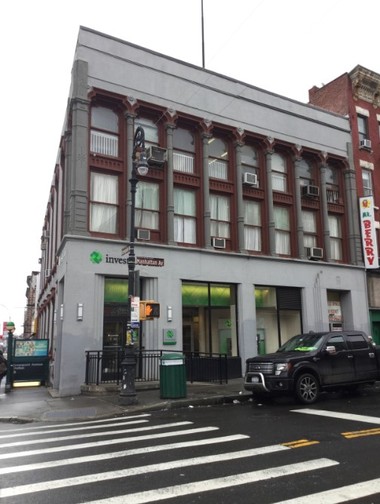
View across Greenpoint Ave. to Smithsonian Hall in 2018 (NYS CRIS)
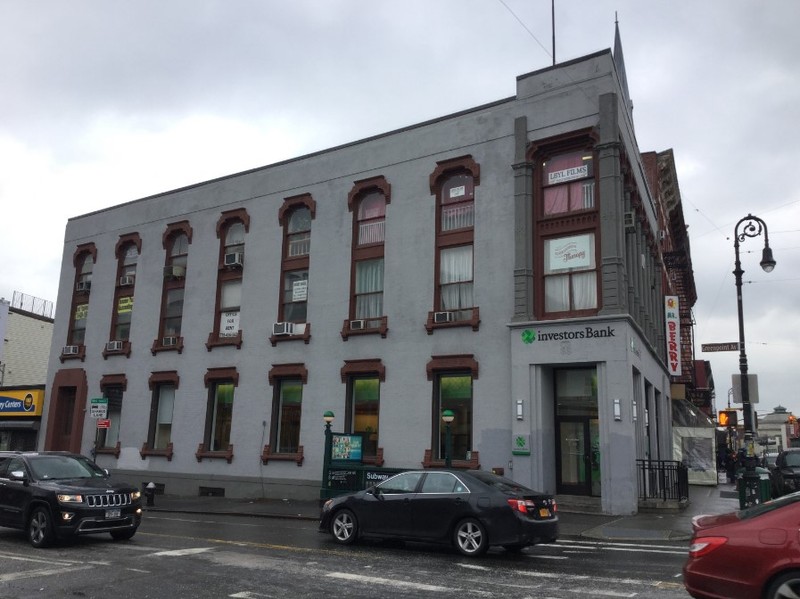
Detail of Greenpoint Ave. east doorway to upper levels with 1930s Art Deco framing, in 2018 (NYS CRIS)
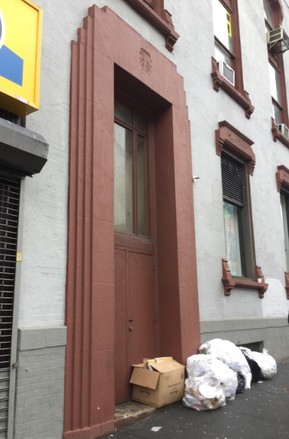
Smithsonian Hall (green arrow) on 1905 Sanborn map (V. 4 p. 45)
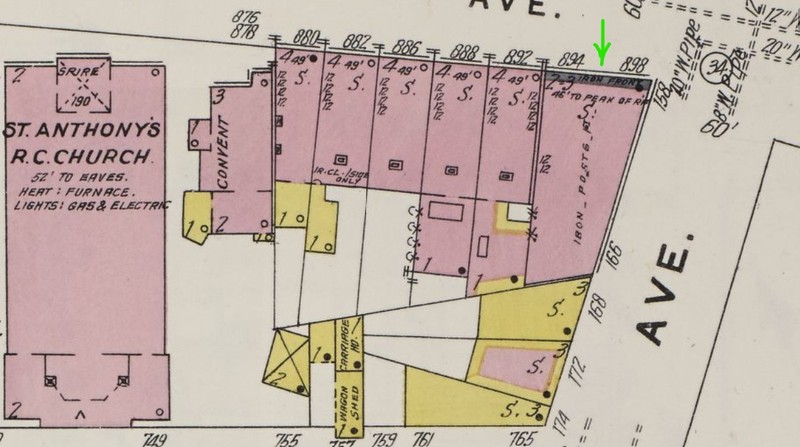
Smithsonian Hall (green X) on Greenpoint Historic District map by NYC LPC (Wasserman 1983)
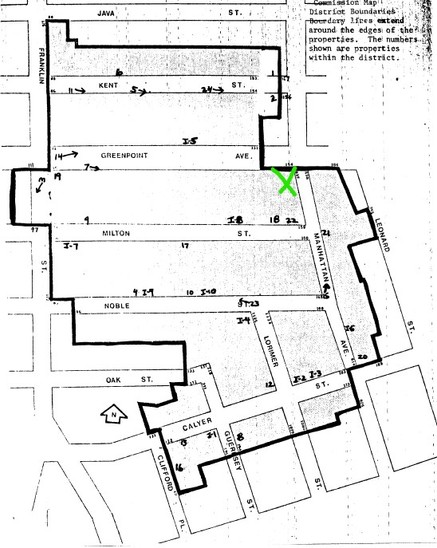
Backstory and Context
Text-to-speech Audio
The Smithsonian Hall building was designed by architect William H. Gaylor for Edward Smith. Gaylor was a master builder and was appointed Commissioner of the Department of Buildings by the Mayor of Brooklyn in 1882. The hall is his only known cast iron structure. The building was probably built using cast iron to reassure the public that it was more fireproof than earlier buildings; several horrific fires had caused casualties and destroyed theaters in New York and Brooklyn. The facade of the two upper floors features a two-story monumental arcade. The ground-floor commercial spaces were renovated in the 1930s, and the secondary doorway on Greenpoint Ave. leading to the upper floors was framed in brownstone in an Art-Deco design. The original roof cornice was probably removed in the 1930s as well.
Edward Smith was working as a tailor in Manhattan in the 1830s when he decided to manufacture ready-made clothing for children and young men. At that time, clothing was made-to-order. Smith established a wholesale clothing business on Maiden Lane in 1834 and partnered with Allen Gray in 1845 to form a retail clothing business, Smith Gray & Company. Smith outgrew his building and had a cast iron structure built in Brooklyn in 1870 at 95 Broadway. An additional store was established in our new building built in 1878 on Manhattan Ave., with the Smithsonian rental hall above. Mr. Leslie Gray was in charge of the new store in the Smithsonian Hall building. The clothing firm's tailoring plant, where all of its clothes were made and shipped to retailers across the country, employed 1,500 by 1888; the factory still employed 250 workers by 1909.
The play "Uncle Tom's Cabin" was performed in the newly built hall in February and June 1879. The "Anti-Dyspeptic Cooking Club" rented the hall in February 1889 for an evening of musical and literary entertainment, the day after the Jefferson Club held a dance in the hall. A lightweight wrestling match between brothers Tom and Martin Dempsey was held in the hall in March 1890; Tom won two of three matches. The ground floor store was Smith's clothing store, Smith Gray & Company, until around 1905. The firm still operated two other stores in Brooklyn and two in Manhattan by 1911. The Smithsonian Hall building was renovated to be converted into the Seventeenth Ward Branch of Union Bank in 1906, with office spaces above. Corn Exchange Bank of Manhattan moved into the ground floor in 1910.
Smithsonian Hall is within the Greenpoint Historic District, recognized by the New York City Landmarks Preservation Commission and the National Register. The district is bounded roughly by Kent Street on the north, Manhattan Ave. on the east, Calyer or Noble Streets on the south, and Franklin St. or Clifford Pl. on the west. Most of the buildings within the district are residences built individually from the 1850s to the early 1900s, plus six churches, two banks (including Greenpoint Savings Bank, also a Clio entry), and ground-floor commercial buildings along the major streets. Development was initially spurred by the need for residences for workers along the busy waterfront industries of Brooklyn. The residences were generally finer homes for the factory managers and less spacious, walk-up flats for the factory workers.
Sources
Anonymous. "A Fine Edifice. Smith, Gray & Co.'s Imposing Structure." Brooklyn Daily Eagle (Brooklyn) October 24th 1888. 2-2.
Anonymous. "Greenpoint Gossip." The Brooklyn Citizen (Brooklyn) February 17th 1889. 6-6.
Bolton, H Philip. Women Writers Dramatized. New York, NY. Mansell Publishing, 2000.
Corvin, Tim. Pioneers of Professional Wrestling: 1860-1899. Bloomington, IN. Archway Publishing, 2014.
NYC Landmarks Preservation Commission. Designation Report, Greenpoint Historic District. New York, NY. NYC Government, 1982.
Smith Gray & Co.. "Foremost Clothiers Since 1845, Smith Gray & Co. Advertisement." Standard Union (Brooklyn) September 22nd 1911. 8-8.
Wasserman, Fred. NRHP Nomination of Greenpoint Historic District, Brooklyn, N.Y. National Register. Washington, DC. National Park Service, 1983.
Yorkton. Smithsonian Hall, Novelty Theater. October 13th 2020. Accessed March 9th 2022. https://noveltytheater.net/buildings/smithsonian-hall.
New York State Cultural Resource Information System (NYS CRIS): https://cris.parks.ny.gov/Default.aspx
NYS CRIS: https://cris.parks.ny.gov/Default.aspx
NYS CRIS: https://cris.parks.ny.gov/Default.aspx
Library of Congress (LOC): https://www.loc.gov/item/sanborn05791_016/
NYS CRIS: https://cris.parks.ny.gov/Default.aspx
